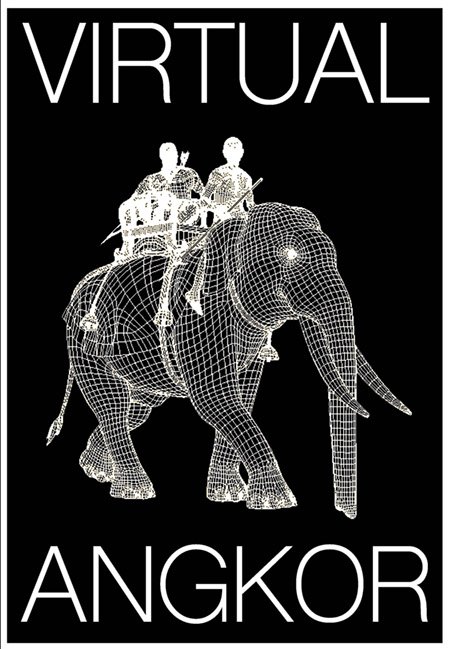Unexpected Trade Goods
Angkor was closely connected to wider networks of trade and diplomacy. In this teaching unit, we explore an unlikely trade good.
The Kingfisher as Commodity
Although Angkor seem isolated today, the Angkorian empire that we depict in the Virtual Angkor project was closely connected with wider circuits of trade and diplomacy. In the above image, you can see a snapshot of how the world of Virtual Angkor is handcrafted. You might also notice an unexpected trade good.
The blue-eared kingfisher, which is native to the Indian subcontinent and Southeast Asia, was an extremely important trade good from the region. In a book focused on kingfishers, Ildiko Szabo writes that “We should not underestimate the importance of this trade good.” The most valuable parts of the small bird were its feathers, which were prized for their vibrant colors and used as pigments in jewelry, headdresses, and other decorative items
The trade in kingfisher feathers between the Angkorian and Chinese empires flourished between 802 and 1431 CE. The primary consumers were in China, which was a vast economic and political superpower in this period. This trade was a central part of the Angkorian economy, and even helped fund the creation of Angkor Wat. Additionally, the Khmer people traded these feathers in exchange for porcelain, paper, sulfur, canvas, cloth, iron and copper tools, wooden combs, and other Chinese products.
The Khmer empire was not the only source of kingfisher feathers. In an important article Roderich Ptak shows that such feathers were sourced from across Southeast Asia including modern day Thailand and Vietnam and as far afield as Sri Lanka. Ptak concludes that “kingfishers and their feathers were highly esteemed in China and regularly brought in from Southeast Asia over a long period of time.” But although such features were sourced more broadly, Angkor was an important site. Adrien von Ferscht explains that “finest kingfisher feathers were to be had from Cambodia and were prized above all. The export trade of feathers to China was one of the largest export earners for the Khmer empire.” (Szabo, Kingfisher)
Questions
What strategies or techniques do you think went into capturing kingfishers so that they could be traded?
Who might have been the main group of people capturing and trading kingfishers to foreign merchants?
Jewelry and Ornamentation
The name for jewelry and other ornamentations that utilized kingfisher feathers was tian-tsui, which literally translates as “dotting with kingfisher.” The first record of tian-tsui dates back to 300 BC. In total the practice lasted for over 2000 years until the Chinese government classified kingfishers as a Class 2 Protected Animal during the Chinese Communist Revolution.
Because of the fragility of the pieces, the technique was mostly reserved for hair ornaments, brooches, and other similar pieces reserved for special occasions. Additionally, their use was reserved for the Imperial Court.
Examine the two tian-tsui examples below.
Hair pin in the shape of a small sprig of flowers and leaves, with kingfisher feather decoration, China, 20th century (TRC 2023.2526). https://www.trc-leiden.nl/trc/index.php/en/blog/1581-kingfisher-feathers-and-chinese-hair-ornaments
Tian Tsui headdress. Dianzi. China, Qing Dynasty, 19th century Victoria and Albert Museum. Accession no. 937-1902. https://www.mocanyc.org/collections/stories/conservation-treatment-of-a-tian-tsui-headdress-from-the-moca-collections-by-devon-lee/.
Note the vibrancy of the kingfisher feathers. This color would be impossible to reproduce throught the use of available pigments at the time. For this reason, it was both highly valued and highly priced.
Questions
Try to count the amount of feathers used in each tian-tsui creation. How many kingfisher birds do you think would go into making each one?
Why do you think these pieces were so fragile?
Why might these pieces only be reserved for the royal court?
The Cost of Color
The kingfisher was sought after because of the unique and eye-catching appearance of their feathers. But these feathers had to be handled extremely carefully to ensure that they were not damaged, and thus the color was ruined.
Unsurprisingly, the massive trade resulted in environmental degradation.
Fletcher argues that Angkor’s increasing population placed enormous pressure on forest resources, using large amounts of wood for temple construction, housing, and daily fuel needs. This intense exploitation likely stripped nearby forests, triggering soil erosion and clogging rivers with sediment. These environmental disruptions may have caused oxygen levels in the water to drop, harming fish and other aquatic creatures that thrived in rice fields and waterways. As these food chains collapsed, kingfisher populations would have suffered from the loss of prey and nesting areas. At the same, they were subjected to relentless pressure as a highly desirable good in a sprawling commodity chain.
Questions
In what ways did the kingfisher trade impact the environment beyond the deaths of the birds?
Can you think of any animal products in recent history that had the same environmental impact as the trade in kingfishers?
Further Reading
Daguan, Zhou. A Record of Cambodia: The Land and Its People. Translated by Peter Harris. Chiang Mai: Silkworm Books, 2007.
Szabo, Ildiko. Kingfisher. London: Reaktion Books, 2009.




